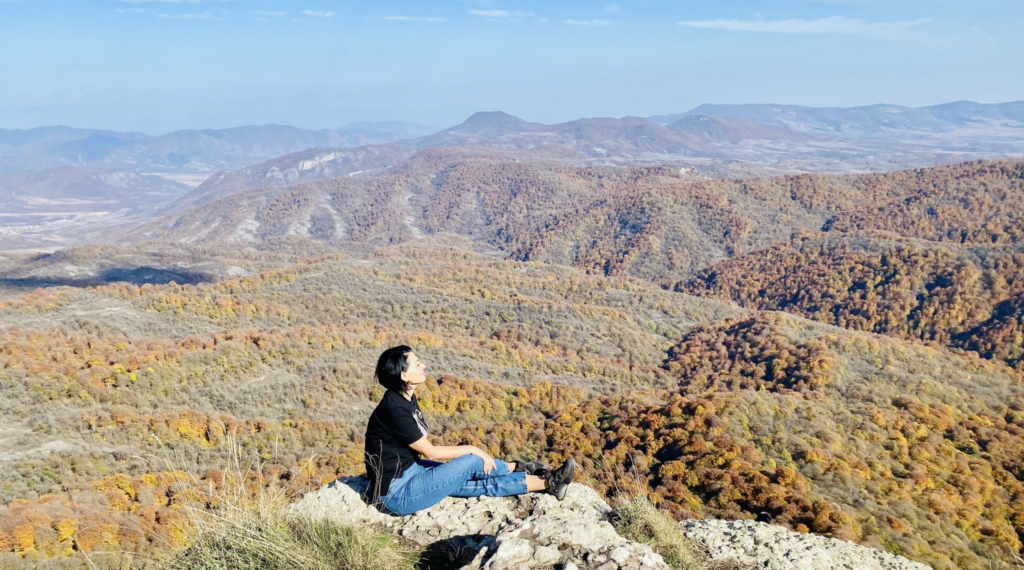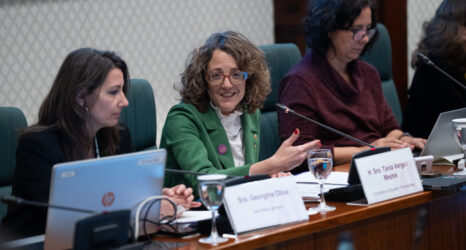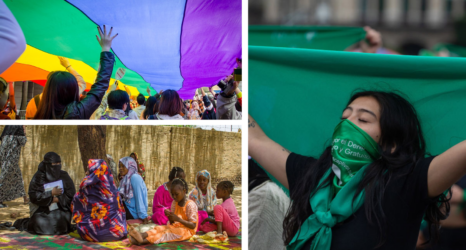“This is history,” said Siranush Sargsyan of the genocide against 120,000 Armenians living in Nagorno-Karabakh. “This is also my story, my family story. I’m also the victim of the war that I report on.”

For nearly three years, Siranush Sargsyan has documented Azerbaijan’s siege of the 120,000 indigenous Armenians in her disputed homeland of Artsakh (Nagorno-Karabakh). The former history teacher and state worker turned wartime freelance journalist is now among the over 100,700 forcibly displaced taking refuge in neighboring Armenia.
“I’m the protagonist of the photos and articles I produce because I want to tell these stories. This is history. This is the reality we must show,” said Sargsyan, an Artsakh native, now living in the neighboring Republic of Armenia. “This is also my story, my family story. I’m also the victim of the war that I report on. This is also my reality and I show it with hopes to end the atrocities we endured.”
Sargsyan, 39, has survived two major wars (1992-94 and 2020) while documenting Azerbaijan’s systematic ethnic cleansing of the disputed enclave. She has witnessed indiscriminate atrocities upon her people, and lost countless family members, acquaintances, classmates and teachers. She lived through the Azerbaijan-imposed starvation campaign for nearly 10 months—which sealed off Artsakh from the outside world, cutting off electricity, food, gas and medical supplies.
Azerbaijan’s final offensive, under the guise of “anti-terrorist activities” on Sept. 19 brought further bombing to the besieged civilians across Artsakh. Sargsyan’s social media posts showed weary residents sheltering in basements, scenes of barraged apartment buildings, and a haunting image of a mother and child clinging together (distributed via AP). In her BBC article on a traumatized mother whose 8- and 10-year-old sons were victims of the bombing, she detailed a mother’s insistence to transport her children’s remains to Armenia for burial.
“When the Sept. 19 bombardment started, I first rushed into a basement shelter, then soon walked out and started to video the distant smoke from the bomb blasts, the silence and the voices. The neighborhood’s bombed buildings haunted me the most—I walked the backyards under the sky-high laundry lines the women proudly hung.” said Sargsyan. Her footage of backyard laundry lines flapping in mid-air between high-rise buildings was among her last from Artsakh.
Delaying her departure, Sargsyan couldn’t reconcile the emotional trauma of leaving behind her generational home, her life of 39 years—unable to physically disconnect from her homeland.
“Azerbaijan didn’t provide a realistic option of co-existence. Its military took over our lands letting us know that we should leave,” Sargsyan’s posted on X, formerly known as Twitter, captured her state of mind:
In like one day, you lose everything. I lost myself. I wanted to stay more, to remember every corner of my city.
Siranush Sargsyan
When she finally packed, she chose a few precious earrings and books from her collection. She left behind most of her clothing with memories of a happier life in Artsakh, and her special rug, too heavy to carry. She met others in the crowded town square of the capital city Stepanakert to join the snaking queue of overpacked cars and buses spilling out of Artsakh through the mountainous road toward Armenia—an exodus visible through satellite images from space. The heavens watched the trail of tears and memories of the horrors of an exodus from the ancient land while world powers remained largely immobile to calls for action.

Sargsyan compares the “physically, emotionally and psychologically unbearable” 30-hour grueling exodus, to the forced march of her ancestors 108 years ago during the Armenian genocide. The Ottoman Turks forced hundreds of thousands of Armenian refugees into death marches through the scorching heat of the Deir ez Zor desert in modern-day Syria.
“Maybe it’s not comparable, but the pain and trauma we lived through over the past years, and the nearly 10 months of blockade, felt like we were bleeding daily, drop by drop. Then Azerbaijan completed its mission by bombing us—and the final assault of the gas depot explosion was indescribable. Azerbaijan turned our heavenly country and our lives into a hellish existence. People just wanted to run away from that hell.”
At each stop on the journey toward Armenia, she conversed with the dazed and traumatized residents—some displaced multiple times—but all aspiring to return to Artsakh. After some 30 hours, arriving at the central-eastern border village of Kornidzor in Armenia, in the early morning hours, she was welcomed to her “homeland” of Armenia by volunteers offering food and water.
Feeling “limbless,” she walked through the large crowds of her countrymen hovering and lined up around humanitarian aid tents.
“It was unbearable. We didn’t realize at that time that this was our last journey out of our homeland. For the first time, I realized I was a refugee who didn’t have a home,” Sargsyan said.
“I’m surprised when journalists ask me ‘Why didn’t you stay in Artsakh?’ It’s really frustrating—they don’t know or pretend they don’t know that we didn’t have any other choice—and wouldn’t be alive if we stayed. We want the rest of the world and everyone to know that we had no other choice but to leave our homeland. We were victimized and not offered any other alternatives.”
Sargsyan said many families lost loved ones days before their departure. “This is not a normal thing for people, to bury relatives and the next day flee their homeland.”
The Proud Indigenous Armenians of Artsakh
Sargsyan is a native of Sos, a grape farming community in eastern Artsakh of just over 1,000 inhabitants—home to the Fourth-Century Christian Armenian Amaras Monastery, where Armenian alphabet creator, Mesrop Mashtots, established the first Armenian school. Armenia adopted Christianity as its state religion in 301 AD, which is reflected in the centuries-old Christian Armenian cathedrals and monasteries dotting Artsakh and Armenia’s rugged mountain terrain and valleys.
In her quest to “change the world,” Sargsyan entrenched herself in politics. She taught herself English and was employed in the Artsakh parliament, where she enrolled in the Public Administration Academy to study political science.
“I wanted to see more women in politics who could improve decision-making and create a better living environment in Artsakh,” Sargsyan said. She even campaigned, unsuccessfully, for the 15-member all-male Stepanakert City Council.
In September 2020, Azerbaijan, with NATO member Turkey’s backing, unleashed an unprovoked 44-day war on Artsakh. Amnesty International’s Crisis Response experts “identified Israeli-made M095 DPICM cluster munitions” used by Azerbaijan. Over 5,000 died and thousands were displaced by the time Azerbaijan and the Republic of Armenia signed a tripartite Russian-brokered ceasefire agreement on Nov. 9, 2020, ending the war in strong favor of Azerbaijan. Russia installed 1,960 peacekeeping forces in Artsakh, which failed to secure the Armenian population’s safety through the last hours of the exodus.
“After the 2020 war, we lived under an information blockade. So, I decided I should speak up. The bloody war and the stories of all our suffering had to be told and published,” Sargsyan said.
Her mission to amplify the stories of those “still alive and struggling” brought her to a six-day training initiated by the AGBU Young Professionals of Madrid (Spain) and Ronak Press non-profit from Spain’s Basque Country, which convenes local journalists to cover war stories. Her first article covered the opening of a French cultural center in Artsakh, followed by “Female Faces of the Artsakh War” published in the Boston-based English language publication, The Armenian Weekly.
“I wanted to show the female face of the Artsakh war. Men are always portrayed as heroes. Surely many of our men lost their lives, but women suffered too. They took care of the children while enduring unbearable struggles. It’s no coincidence that most of my heroes happen to be women,” Sargsyan said.
Months after the 2020 war, walking the streets she imagined seeing the faces of those who had died. She remembers in tears the loss of her beloved uncle but gets most emotional detailing the death of her brother-in-law, a special forces soldier. His death dramatically impacted her “smart university graduate” sister, who had chosen to be a stay-at-home mom to “pamper her son and husband.” Their 20-year marriage ended on Nov. 7, 2020, two days before the ceasefire agreement, when Azerbaijani forces launched devastating attacks on the strategic Armenian fortress stronghold of Shushi—crowned atop mountains and home to the iconic Ghazanchetsots Cathedral which was damaged by two targeted missiles.
“My sister refused to cross the border into Armenia from Shushi, because that’s the road where her husband’s blood spilled.”
Sargsyan says her 3-year-old nephew never questioned his father’s absence but obsessively watched the TV program that profiled martyred soldiers. “I wondered whether he understood that his father wasn’t coming back because we didn’t tell him he had died. He never asked for toys, but one day he asked me, ‘Can you ask them to show my father on TV?’”
A Homeland of Generational Memory
Sargsyan said she felt most protected (despite Azerbaijan’s siege), and psychologically stronger while living in Artsakh.
“Since my childhood, I’ve considered living in Artsakh as a special privilege because we have sacrificed a lot,” she said. “This is the high price we paid for living in our homeland. This is our choice. Our mountains, our culture, are part of our being. I exist within my land and soil. We sacrificed our blood to remain in our ancestral land where our spirits lie. Even to the last moments before our exodus—we hoped for a chance to live in our country. We won’t ever find another place as beautiful as Artsakh.
While she’s come to terms that Armenia is now her home, she feels weakened—she said she has “lost almost everything,” but is grateful for “the beautiful homeland which still exists and must be preserved.”

Sargsyan recalled seeing one of the village teachers at the border. The young, hardworking teacher had a large vineyard and had built a beautiful house she frequented. She was saddened to see all that he had now, was a tightly packed, small car—carrying his children, wife and elderly parents.
“Their stories, every house, every person, every plot of land and mountain that made up our homeland of Artsakh is now strewn.” Sargsyan said the blockade felt like being imprisoned and the prospects of its lifting felt as impossible “as reaching another Galaxy”.
Azerbaijan’s siege over Artsakh continued to the end, despite a February 2023 order by the International Court of Justice ordering Azerbaijan to end the blockade, echoed by countless international and humanitarian organizations.
In her dreams, Sargsyan said she sees herself “back in Artsakh.” Her compatriots share her sentiments—reliving in their minds their previous lives spent baking bread, harvesting their vineyards and gardens into wine and pickled vegetables, building their homes, and surviving Azerbaijan’s “agricultural terror” sharpshooters targeting farmers in their fields. Talking about the memories and the trauma, she said, has healing powers for her and the others, “as painful as it is.”
“With each day passing, I feel as though the anesthesia is wearing out and the pain is harder to bear.”
For Sargsyan and over 100,000 forcibly displaced Artsakh Armenians, the personal trauma of ethnic cleansing and war atrocities remains constant and the post-conflict psycho-social needs will only deepen in the future.
For now, the fertile, bomb-strewed vineyards and orchards, overshadowed by the Kirs peak nestled within the Artsakh mountain range, remain unharvested. The ancient monasteries’ bell towers are silenced for the first time as the winds of despair swirl through the mountain ranges and valleys and across ghost towns and villages empty of their indigenous residents who for centuries cultivated the land and endured harsh mountainous winters through wars. For the first time since 1967, the Tatik-Papik We Are Our Mountains monument, symbolizing Artsakh’s resilience, is endangered.
Up next:
U.S. democracy is at a dangerous inflection point—from the demise of abortion rights, to a lack of pay equity and parental leave, to skyrocketing maternal mortality, and attacks on trans health. Left unchecked, these crises will lead to wider gaps in political participation and representation. For 50 years, Ms. has been forging feminist journalism—reporting, rebelling and truth-telling from the front-lines, championing the Equal Rights Amendment, and centering the stories of those most impacted. With all that’s at stake for equality, we are redoubling our commitment for the next 50 years. In turn, we need your help, Support Ms. today with a donation—any amount that is meaningful to you. For as little as $5 each month, you’ll receive the print magazine along with our e-newsletters, action alerts, and invitations to Ms. Studios events and podcasts. We are grateful for your loyalty and ferocity.





